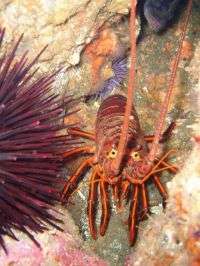Scientists explore ways to improve management of California spiny lobsters

Unique, collaborative ways to manage fisheries are emerging in Southern California. Currently the California spiny lobster is being scrutinized as Californians evaluate the first five years of marine reserves in the Channel Islands area.
An innovative collaboration has developed between local trap fishermen and scientists at the Bren School of Environmental Science and Management at the University of California, Santa Barbara. The partnership, called CALobster (), has ambitious long-term and short-term goals.
The long-term goals include involving fishermen in fisheries research and management, ensuring the sustainability of lobster populations, and maintaining working harbors. In addition, CALobster is building an education program to train graduate students in community-based fisheries management. The community includes fishermen, scientists, managers, environmental groups, and general public.
A series of short-term studies have been conducted to support the longer-term goals. They include assessment of a recent and controversial management decision to establish no-take fishing reserves at the Channel Islands.
Research conducted by CALobster will be presented at an upcoming special symposium Friday morning. Entitled The First Five Years of Monitoring the Channel Islands Marine Protected Area Network, the symposium, free and open to the public, is at the Embassy Suites Mandalay Beach Hotel and Resort, 2101 Mandalay Beach Road in Oxnard.
Hunter Lenihan, a professor at UC Santa Barbara’s Bren School and a CALobster researcher, explained that the results to be presented at the symposium are preliminary because analyses and sampling are on-going. Nevertheless, patterns observed so far are very interesting, according to Lenihan.
“Lobster populations inside reserves tend to have greater proportions of individuals of large sizes,” said Lenihan. “Traps deployed inside reserves consistently had equal or higher average catch rates than those outside reserves, with some exceptions.”
In addition, trapping conducted by Matt Kay, a UC Santa Barbara graduate student and CALobster co-founder, and fisherman Chris Miller, another co-founder, explain that larger lobsters, once feared to be completely fished-out, are present in the Channel Islands both inside and outside of reserves.
Intensive monitoring of the lobster population began two years ago. Kay cautioned that lack of data on the lobster population structure before reserve implementation limits the ability to interpret the differences we see today.
“This lack of ‘before’ data undermines our ability to identify reserve effects unequivocally,” said Kay. “For example, the trends in population structure and trap yield we observed may be driven by habitat characteristics, since some traditionally high-yielding reefs were placed inside reserves. CALobster provides a starting point for monitoring reserve impacts on spiny lobster. We recommend that monitoring of marine resources precede future reserve implementation in California.”
Efforts by the collaboration to help develop community-based research to inform management are on-going. Of special concern is creating lower-cost, more effective forms of management that involve all stakeholders.
“The grass roots of the community must be involved,” said Lenihan. “After all, we all eat fish. In particular, many of us choose to eat local fish, meaning that we must sustain local fisheries. We cannot just conserve lobster populations but we must focus on conserving fishing communities.” Kay added: “It’s important to remember that working harbors not only have economic value, but also contribute to the character of coastal communities.”
According to the CALobster website: “CALobster provides a forum for fishermen, together with scientists, managers, and others, to participate productively in fisheries and reef ecology, data collection, and other research activities designed to advance spatially-explicit stock assessments, ecosystem-based and zonal-based management, and the conservation of fishing cultures. We are a collaboration of marine stakeholders, including especially the California Lobster and Trap Fishermen's Association (CLTFA) and UC Santa Barbara marine scientists.”
CALobster is training students in multi-disciplinary approaches to fishery ecology and fisheries co-management. According to the website: “This is possible only with the participation of committed mentors, including fishermen, ecologists, economists, anthropologists, trades people and craftsmen, policy makers, managers, and philosophers.”
Source: University of California - Santa Barbara















